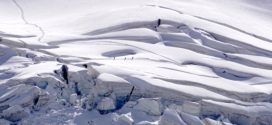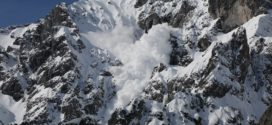This article is based on the European scale of avalanche danger. The level of danger depends on a number of variables, in particular the stability of the snowpack (or the likelihood of an avalanche), the prevalence of avalanche-prone areas, and the size of the avalanche. The level of danger always refers to the region and not to one particular slope. The level of danger given on the avalanche bulletin is always a forecast and should be verified on site.
Content
Danger levels - a simplified picture of reality
* Avalanche prone areas are described in more detail in the avalanche bulletin (altitude, slope, type of terrain):
- moderately steep terrain: slopes less than 30 degrees
- steep slopes: slopes steeper than about 30 degrees
- very steep, extreme terrain: particularly unfavorable terrain related to slope (greater than 40 degrees), terrain profile, proximity to ridge, flat ground
** Additional loads:
- low: individual skier/snowboarder, rides smoothly, does not fall; snowshoes; group with good constant distance between participants (minimum 10m)
- high: two or more skiers/snowboarders, etc. Without sufficient spacing; snowmobile; explosives
The danger of an avalanche does not increase linearly from level to level, but disproportionately. This includes the following variables:
- if the stability of the snow cover, and with it the additional load required to trigger an avalanche, decreases, and the likelihood of an avalanche triggering increases;
- if the prevalence of avalanche-prone areas increases, this means that there are more places where avalanches are released naturally or can be provoked;
- if the size of the avalanche increases. If the additional load required to trigger an avalanche decreases, and there are more places where avalanches can occur, the likelihood of an avalanche triggering increases. This is also shown by the stability distribution in the diagram below.
Moderate avalanche danger. Small, lightweight wind cookers
A lonely outdoorsman in the countryside can often cause a buildup of fresh snow. The size of these so-called wind slabs depends not only on the wind, but also on the influx of fresh snow or loose old snow surface. The size of the wind slabs depends on the amount of snow blown by the wind and the wind speed itself. In case only a small amount of snow can be transported, the wind plates remain small. If a skier lowers these small wind slabs, the avalanches tend to stay small. Therefore, deep burials are unlikely. While the likelihood of a release in this example could be quite high, forecasters rate these conditions as a hazard level of 2-moderate.
With a certain amount of practice, windblown snow accumulation is usually fairly easy to assess when good visibility prevails. In general, wind slabs should be avoided, especially in terrain where slips and falls can be fatal.
Significant level of avalanche danger. Deep stable weak layers
Deep-seated persistent weak layers (eg, surface frost, cold-on-warm/warm-on-cold basal faces) are difficult to induce because it is very difficult to initiate a crack. The triggering of deep stable weak layers is likely to occur where the snow is relatively shallow or during transitions from shallow to deep snow. In the case of a permanent weak layer, the problem with a noticeable stable weak layer deep in the snowpack prevails.
Dangerous spots where a single skier can cause a fracture are relatively rare. However, if disruption occurs, avalanches can often become dangerously large for outdoor enthusiasts in rural areas – in other words, often fatal. Thus, the avalanche forecaster often rates these situations as a 3-Significant avalanche hazard, even though avalanche start locations are rarely distributed. The situation is complete enough for outdoor enthusiasts to appreciate, as trigger points are often very difficult to detect even with advanced skills and a trained eye. The persistent weak layer problem results in more avalanche fatalities than any other typical avalanche problem.
High level of avalanche danger. Occurs at an altitude popular with skiers
If numerous large and, in many cases, very large spontaneous avalanches are expected, the avalanche danger is rated as 4-high. Under such conditions, vulnerable places (usually sections of transport routes, and in some cases buildings) are at risk. In addition to these classic avalanche level characteristics of 4-High, there is another scenario where large avalanches are unlikely to be expected (for example, because there is still too little snow at the start of winter), but medium to large avalanches are plentiful. is naturally released and/or can be triggered very easily in multiple locations. In this case, weather forecasters speak of “skier height”. These situations pose a serious danger to outdoor enthusiasts, while transport routes remain unchanged or are only affected in individual cases.
Very high level of avalanche danger. Avalanches as a result of wet and sliding snow cover
Skiers can hardly provoke wet avalanches, and in the case of sliding snow avalanches, this is almost impossible. Therefore, natural triggering is the main cause of these types of avalanches - even at lower hazard levels.
In fact, the definitions of the maximum possible spontaneous avalanche activity at the lower end of the avalanche danger scale refer mainly to wet snow and sliding snow avalanches. In this context, large spontaneous avalanches are possible when there is a 2-moderate avalanche hazard for conditions that cause sleet or sliding snow. In the case of avalanche-producing conditions, this natural avalanche activity usually corresponds to a 3-digit avalanche hazard, since in this case the avalanches are expected to be triggered by humans.
Danger and risk of an avalanche
Hello, I am Alexander, the mastermind behind the blog.
In terms of career and free time, I connected my life with the forest. How else, when you live in Karelia! In this blog, I am responsible for the hunting, hiking and equipment sections. Welcome to my world!
 Survival Lessons Tips for the survivalist, fisherman and hunter
Survival Lessons Tips for the survivalist, fisherman and hunter

